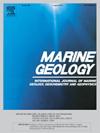Sedimentation dynamics on the Maldives carbonate platform in response to Quaternary monsoonal forcing and sea-level changes
IF 2.2
3区 地球科学
Q2 GEOSCIENCES, MULTIDISCIPLINARY
引用次数: 0
Abstract
Based on the sedimentological, geochemical and mineralogical analysis of two piston cores recovered from the Maldives, an isolated carbonate platform situated in the northern Indian Ocean, this study aims at unravelling the complex Quaternary glacial-interglacial variability within peri-platform ooze deposited in the Inner Sea sedimentary basin, compare sedimentation dynamics between proximal and distal basin locations, and develop a conceptual model, which characterises the interplay between highstand shedding, early diagenesis, water circulation and oceanic current amplification in response to sea level changes and the monsoon.
The results of this study show that at the proximal location, a pattern of re-sedimentation occurred over the last 280 ky, marked by the development of hiatuses during MIS 7 and partially during MIS4–2. Distally, a continuous sedimentation record was present covering the full glacial – interglacial cyclicity, including sediment production and export, over the same time interval.
The processes that may be associated with the abovementioned sedimentary evidence include strong forcing of monsoonal oceanic currents on sediment production and export, commonly referred to as highstand shedding, and on sediment distribution pathways, during Quaternary glacial and interglacial periods. This sediment distribution process includes forcing by oceanic water masses through narrow inter-atoll channels, also bathing the reef bodies on Ari atoll, and the off-bank transport of shallow-water skeletal and non-skeletal material towards the Inner Sea during interglacial periods.
Contrastingly, during glacial intervals, the major atolls were exposed, and oceanic currents associated with the summer monsoon were forced solely through the inter-atoll channels. As the water masses associated with these currents moved through a channel they were amplified, which in turn increased their capacity for erosion and bedload/suspension transport. This led either to the formation of sedimentary gaps or sedimentary hiatuses, but also of sediment drift bodies that moved large sediment masses back and forth along the channel axis. It is likely that these drift bodies switched direction between the summer and winter monsoon season and/or between periods of stronger summer monsoon and stronger winter monsoon throughout the middle and upper Pleistocene and the Holocene, which lead to the observed variations in sedimentation dynamics between the proximal and distal site.
As part of the study, a custom Dynamic Time Warping (DTW) algorithm was developed. Application of this methodology to a reference core showed that it quickly established an age model for a particular core, picking up glacial-interglacial variability and maximum age ranges very well. However, the methodology falls short of completely deciphering the complex sedimentary records as the proximal core discussed here exhibits a sedimentary sequence which reflects complex re-sedimentation processes that blur glacial – interglacial variations.
第四纪季风强迫和海平面变化对马尔代夫碳酸盐台地沉积动力学的响应
本研究通过对印度洋北部孤立的碳酸盐岩地台马尔代夫的两个柱塞岩心进行沉积学、地球化学和矿物学分析,旨在揭示内海沉积盆地台地周围软泥沉积的第四纪冰期-间冰期复杂变化,比较盆地近端和远端位置的沉积动力学,并建立概念模型。其特点是高水位脱落、早期成岩作用、水循环和海流放大响应海平面变化和季风的相互作用。研究结果表明,近端在过去280天内发生了一次再沉积,其特征是在mis7和MIS4-2期间出现了部分断裂带。远端有连续的沉积记录,覆盖了整个冰期-间冰期旋回,包括沉积物的产生和输出。可能与上述沉积证据有关的过程包括,在第四纪冰期和间冰期,季风洋流对沉积物产生和输出(通常称为高水位脱落)以及沉积物分布路径的强烈强迫。这种沉积物分布过程包括海洋水团通过狭窄的环礁间通道的强迫作用,也使阿里环礁上的礁体沐浴,以及间冰期浅水骨骼和非骨骼物质向内海的离岸运输。相反,在冰期期间,主要的环礁暴露在外,与夏季季风有关的洋流只被迫通过环礁间的通道。当与这些水流相关的水团通过通道时,它们被放大了,这反过来又增加了它们的侵蚀能力和河床/悬浮运输能力。这既导致了沉积间隙或沉积断裂的形成,也导致了沉积物漂体沿着河道轴线来回移动大量沉积物。这些漂体很可能在更新世中上段和全新世的夏季和冬季风季之间和/或夏季风强和冬季风强之间转换了方向,从而导致了观测到的近端和远端的沉积动力学变化。作为研究的一部分,开发了自定义动态时间扭曲(DTW)算法。将该方法应用于一个参考岩心,结果表明,该方法可以快速建立特定岩心的年龄模型,很好地提取了冰期-间冰期变率和最大年龄范围。然而,该方法不能完全破译复杂的沉积记录,因为本文讨论的近端岩心显示了一个沉积序列,反映了复杂的再沉积过程,模糊了冰期-间冰期的变化。
本文章由计算机程序翻译,如有差异,请以英文原文为准。
求助全文
约1分钟内获得全文
求助全文
来源期刊

Marine Geology
地学-地球科学综合
CiteScore
6.10
自引率
6.90%
发文量
175
审稿时长
21.9 weeks
期刊介绍:
Marine Geology is the premier international journal on marine geological processes in the broadest sense. We seek papers that are comprehensive, interdisciplinary and synthetic that will be lasting contributions to the field. Although most papers are based on regional studies, they must demonstrate new findings of international significance. We accept papers on subjects as diverse as seafloor hydrothermal systems, beach dynamics, early diagenesis, microbiological studies in sediments, palaeoclimate studies and geophysical studies of the seabed. We encourage papers that address emerging new fields, for example the influence of anthropogenic processes on coastal/marine geology and coastal/marine geoarchaeology. We insist that the papers are concerned with the marine realm and that they deal with geology: with rocks, sediments, and physical and chemical processes affecting them. Papers should address scientific hypotheses: highly descriptive data compilations or papers that deal only with marine management and risk assessment should be submitted to other journals. Papers on laboratory or modelling studies must demonstrate direct relevance to marine processes or deposits. The primary criteria for acceptance of papers is that the science is of high quality, novel, significant, and of broad international interest.
 求助内容:
求助内容: 应助结果提醒方式:
应助结果提醒方式:


